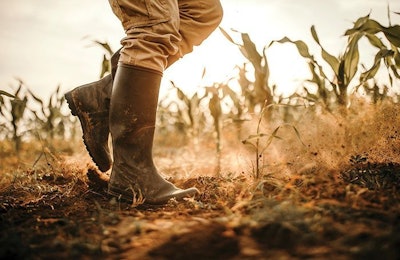
The summer months of 2018 were defined by lengthy dry spells and record-breaking temperatures across much of Europe, particularly the North. According to the World Meteorological Organization (WMO), this “extreme weather” caused widespread impact on human health, agriculture, ecosystems and infrastructure.
During July, temperatures exceeded 86 F in the Arctic Circle, with Norway and Finland both measuring record temperatures, WMO reports show. Elsewhere, Ireland saw a series of heatwaves, and the U.K. had the driest first half of summer on record. Germany and France also saw temperatures soar and exceptional dryness continue.
Effects were so significant and widespread that many national governments and the European Commission (EC) moved to assist the thousands of farmers affected.
Financial support for 'worst hit'
Phil Hogan, European Commissioner for Agriculture and Rural Development, says the EC granted derogations from certain greening measures for farmers in countries worst hit, like Germany, and as many as 17 Member States are now making advance payments to farmers through the Common Agricultural Policy (CAP).
This year, farmer support through the European Union's CAP – an agricultural policy implemented in 1962 – will tally up to $58.82 billion.
Hogan says preliminary assessments post-drought show “significant” impact, particularly in terms of yield losses for cereals. This, in turn, raises concerns for feed availability and animal production, he says.
“While we cannot be definitive at this stage, it does seem safe to say that there will be a reduction in the availability of fodder and increasing costs for livestock farmers over the winter,” he says.
Charles Clack, commodity analyst at RaboResearch Food & Agribusiness, says animal feed makers will notice a considerably “tighter” market.
The drought "was somewhat unexpected, coming in the late stages of the growing season and really taking the market, and taking industry, by surprise a little,” Clack says. “... It's certainly the cereals that have been most badly affected, and it's wheat that has been the hardest hit.”
European wheat tonnage for the 2018-19 harvest year, for example, is forecast at 135.6 million tons, with just 22 million tons for export, he notes, “quite a fall” from stronger, more typical years like 2015-16 where 35 million tons was exported.
Price-wise, he says wheat costs are dramatically higher; December Matif wheat prices increased 17 percent to more than EUR200 (US$225) per ton.
“If I look at that in a historical context, that is the highest price we've seen on French wheat prices since 2014,” Clack says.

Wheat has been hardest hit in this summer's European drought. | pixelfusion3d, iStock.com
Commodity alternatives examined
The cost of making animal feed is now more expensive, which will force industry to consider importing raw materials, likely corn, Clack reports.
“In all, we're seeing much higher prices of wheat in the EU and globally, so when we're looking at imports, corn is now the most competitive feed grain,” he says.
Rabobank forecasts EU corn imports, predominantly from the Ukraine but also the U.S., to rise to 21 million tons for 2018, up from just 18 million tons last year.
Christophe Callu Merite, director of protein raw material purchasing at Feed Alliance, says the inevitable increase in corn use will also drive up demand and use of soymeal to plug the protein differential in the absence of wheat.
“The task for the feed manufacturer is to formulate with less raw material choice and a huge price increase for the fiber part of the formulation, in ratio with protein price,” Merite says.
Given this pressure, new raw materials could arise, he says. “Feed companies are always looking for new raw material, in order to enrich their ability to formulate; it is their goal. ... For instance, sunflower seed hulls or husks that were not used that much as a feedstuff are, this year, being looked at much more as a commodity.”
However, Merite says cost will remain key as feed industry margins rarely exceed 1.5 percent. Quality verification will also be important, he says, especially if companies start sourcing from new countries or suppliers – a trend that is already taking hold.
There are some “unusual” trading roads opening up in Europe, he says, like Spanish straw and alfalfa going to Scandinavian countries. Ireland is also importing feed alternatives for its dairy cows.

As livestock farmers work to compensate for a lack in forages, EU feed manufacturers will make up for the deficit. | ollo, iStock.com
Reaching long-term security
The European Commission will continue to “closely monitor” markets and the situation of livestock farmers in particular, but notes industry, collectively, has to think and plan longer term.
“Extreme weather events are expected to become more frequent and agriculture and farmers continue to be exposed to these more challenging conditions,” Hogan says. “The Commission proposal for the future CAP also includes risk management tools that can be an effective means of enhancing farm resilience. But, it will be up to the Member States whether and how to make use of these support options.”
Nick Major, president of the European Feed Manufacturers' Federation (FEFAC), says this winter will certainly prove challenging for livestock farmers as they work to compensate a lack in forages, but feed manufacturers will respond accordingly.
“Compound feed manufacturers will use their knowledge and experience to find the most cost-efficient feed materials,” Major says. “Feed advisers will be working with their customers to provide nutritional advice to help them through this challenging winter feeding period. This case shows that having access to feed materials available on the global market is of benefit to European livestock farmers.”
Clack says by early 2019, pricing should soften and supplies improve as winter wheat and barley start coming online, although that too will be weather-dependent. For the time being, he says market tightness can be alleviated via imports. The U.S., for example, has had a very strong crop year, and so “there are stocks available, if you pay for them.”















